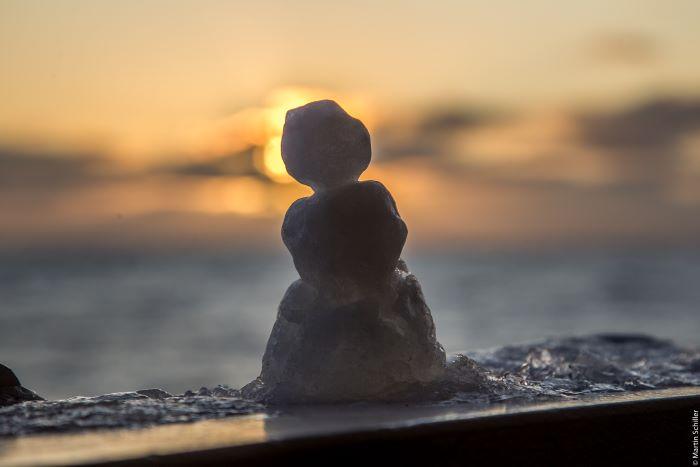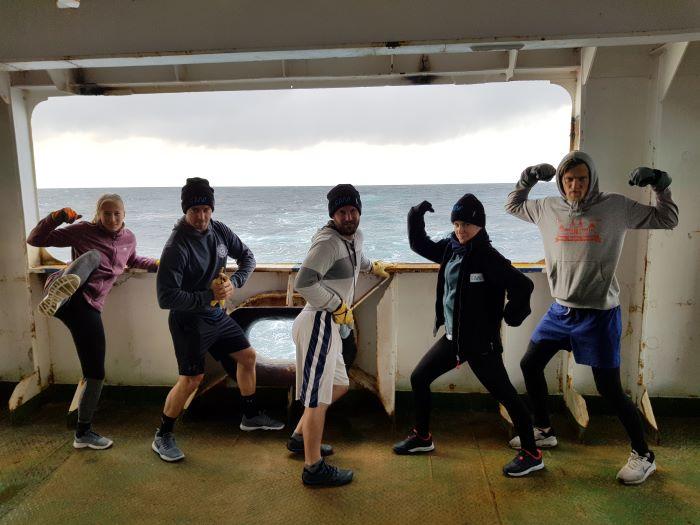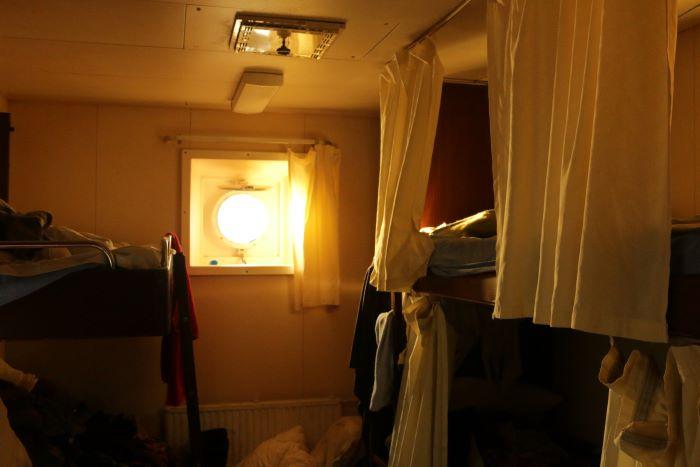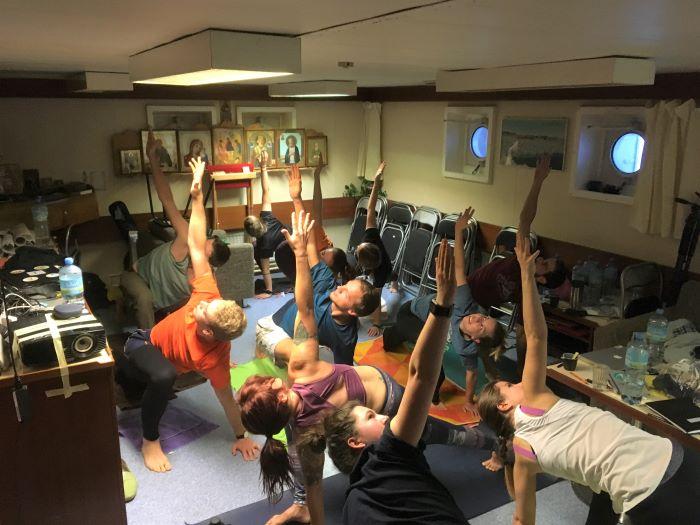Note: Thanks to Maggie Kane and the students in the Odyssey School of Denver Middle School for asking some great questions! Among the 11 questions they sent my way, 3 guided this journal post: Are there health risks (beyond dangers discussed already with bears, and the cold) associated with this journey? What would happen if there was a true medical emergency, that was too big to deal with on board? and Is there any mental health care available to help with conflicts, homesickness etc? Thank you for these insightful questions!

If you are or someone you know is ever in crisis, text HOME to 741741 or call 1-800-273-8255 to be connected with a crisis counselor right away. Please save and share these numbers.
Here in Alaska, winter can be a tough time. Cold and dark can take a toll on people. But at Latitude 59 degrees north, we are rapidly gaining daylight. Since the winter solstice, on December 21, 2019, sunrise has shifted 35 minutes earlier and sunset has shifted nearly an hour later. On December 21, there was about 6 hours of full daylight between sunrise and sunset. On January 26, that amount had increased to about 7.5 hours. This makes a difference. People's spirits seem buoyed. I now can choose whether I walk to work in daylight or walk home in daylight. A couple weeks ago, I was walking in the dark both directions if I worked an 8 hour day. It is even possible to leave work a little bit early and go for a stroll on the ice-strewn beach or a ski through the forest before the sun sets. Based on the other people I see out and about, I'm not the only one enjoying the shift!
But for MOSAiC Expedition participants on the Polarstern, it will likely be another month before they see any daylight. They are currently located at 87 degrees North. The prediction for the next sunrise at their current location is March 11, 2020; those on the Polarstern will likely begin to experience dusky twilight in late February. This is if they continue a westward drift staying close to 87 degrees North. But if their trajectory takes them ever closer to the North pole over the next weeks, the sunrise could be postponed to closer to the equinox (March 21). These numbers come from NOAA's sunrise/sunset calculator. You can use it to predict sunrise and sunset anywhere in the world!
The extended darkness can have some serious health impacts. One key source of Vitamin D comes from exposure of skin to direct sunlight. Lack of Vitamin D can contribute to a number of health problems. Our bodies need Vitamin D to absorb calcium and to build bone density. Vitamin D deficiency can lead to weaker or deformed bones and can increase the risk of osteoporosis (weak bones) later in life. Lack of Vitamin D can also increase the risk of many types of cancer, and can contribute to high blood pressure and heart disease. Vitamin D deficiency can also cause muscle weakness and increase the risk of falls. For people working in the grueling conditions of the Arctic, muscle weakness and falls could be a major problem and make the chances of serious injury higher. Luckily, there is a fairly simple way to prevent Vitamin D deficiency: take a supplemental vitamin. I imagine most people on the Polarstern do just that. For those of us on the Akademik Fedorov during Leg1a, fish featured regularly on the menu. I thought this was just a nod to Russian cuisine, but it might have had an added bonus. Fatty fish can also be a good source of Vitamin D. Luckily for me, sockeye (red) salmon is one of the best food-based sources of Vitamin D. Research also suggests that wild salmon is a better source than farmed salmon. You might remember from my very first PolarTREC journal that I was able to catch some delicious Alaskan sockeye salmon this summer, and I have enough in my freezer to enjoy throughout the winter.
Lack of sunlight can also contribute to Seasonal Affective Disorder, a type of depression that comes and goes with the seasons. There are a number of ways to treat Seasonal Affective Disorder, but a popular approach is exposure to bright, artificial light. I know many people in Alaska who utilize these lightboxes, and at least some of the participants on the MOSAiC Expedition brought these "happy lights" along.
An interesting aspect of the MOSAiC Expedition is that many of those involved haven't spend a prolonged amount of time in the Arctic or Antarctic winter. Even those who have done extensive field work may have only worked there in the summer months. So, many people involved didn't know exactly how their moods and mental health would be affected by the polar night. Polar night isn't the only part of the expedition that can strain mental health. People are far away from their homes, families and friends. They are living in close company with dozens of people, making alone time and personal space a challenge. With so many nations involved, it can be difficult to navigate different cultural norms and expectations. Sometimes decisions made by expedition leadership don't seem fair or just. With access to only what is on the ship and the ice, people may not be able to use their typical coping mechanisms and ways of destressing. And I'm sure there is plenty of stress related to the research itself! Brittle, dynamic ice; polar bears and arctic foxes; extreme weather; severe cold -- all of these have already damaged key research equipment and even put people's lives in danger. For many, this can cause anxiety and worry. Add to that the sad and startling experience of witnessing an Arctic Ocean at the frontlines of rapid climate change, and it seems inevitable that people will struggle.
Some have described the mental health impacts of expeditions like this as Polar Madness. This field of research is growing; the interest seems to be in part because what is learned during Arctic and Antarctic expeditions might be applied to other extreme situations like interplanetary travel. Outside Magazine published an interesting article about this topic. Russian researchers have actually studied the physiological impacts of living in the far north and spending time on Arctic Ocean drift stations. This academic paper provides some insight. In addition to psychological impacts and potential Vitamin D deficiency, prolonged exposure to cold can affect thyroid health and metabolism.
For all of the reasons outlined above, the doctor and other medical staff onboard the Polarstern are well-trained to prevent, diagnose, and treat medical health challenges as well as physical health issues like injury and illness. They are even equipped to perform surgery onboard. But sometimes that might not be enough. Whether it be an extreme mental health challenge, severe injury, or life-threatening illness, there is always a possibility that a medical emergency will occur that cannot be handled onboard the Polarstern. If that happens, the medical crew will stabilize the person as best as possible and then they will be evacuated to additional medical care. There are already helicopters onboard the Polarstern, but the ship is probably too far from land for them to be useful in that sort of situation. Instead, small small airplanes like Twin Otters would likely be used for the medevac. These planes would need to travel from land to the Polarstern. But there is an additional challenge. There is not enough space on the ship for an airplane to land. Instead, members of the expedition logistics crew have used a giant Pistenbully (snow groomer) to clear a 400 meter (1/4 mile) long and 25 meter (80 feet) wide landing strip. The landing strip was completed in early January, making medevac more plausible in a severe emergency.
But preventive medicine is the best medicine. The Polarstern and surrounding main ice camp have been designed to help alleviate both physical and mental health risks. There is a small swimming pool and athletic gym on the Polarstern. Out on the ice, there is a recreational area set up so that people can take brisk walks or ski in a safe area. Staying physically active boosts the immune system and can relieve stress. A movie theater offers additional diversion.

Onboard the Fedorov, we made do with a small "gym" that consisted mostly of a ping pong table. For many, ping pong became a welcome outlet and way of staying physically active. And others lent their skills and knowledge to benefit us all. One researcher guided daily yoga sessions in the MOSAiC School room. One student organized intense, CrossFit-like sessions on the deck and another taught mixed martial arts/self defense. These classes were such great gifts to the rest of us. When snow fell on deck, there were snowball fights and small snowpeople on the ship's rail.
A variety of card games and board games were brought out most evenings, and laughter could often be heard spilling out of the mess hall (dining area). It was especially fun to exchange games across cultures. My favorite game from the ship was SNERTS! It was introduced to the Fedorov by radio journalist Ravenna Koenig; she learned to play SNERTS on the North Slope of Alaska. Thinking back on our games now, I smile. While there were in fact many challenges to life on the Fedorov, I am grateful for the amazing group of people I met along the way. I hope the people on the Polarstern are having as much fun as I did when I scrambled around the table to throw down a card before someone else did.
Education Extension Mental health is such an important topic for young people to learn about. Schools and other educational organizations often have good resources to guide this. Check them out. Look for resources that are relevant to the cultures and communities students are part of. Qungasvik: A Model for Promoting Reasons for Life and Wellbeing in Yup'ik/Cup'ik Communities is a great example of a culturally-responsive, community-driven toolkit.
As a starting point, you could ask students to work in small groups to create lists of what they would bring on an expedition like MOSAiC to stay physically healthy, boost their mood, and cope with stress. Then ask them to reflect on what they do in their day to day lives to reach these goals. With guidance and where appropriate, you can even encourage students to ask friend and family about coping strategies and protective factors.
If you are or someone you know is ever in crisis, text HOME to 741741 or call 1-800-273-8255 to be connected with a crisis counselor right away. Please save and share these numbers.




Comments